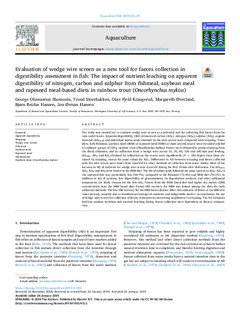| dc.contributor.author | Shomorin, George Oluwaseun | |
| dc.contributor.author | Storebakken, Trond | |
| dc.contributor.author | Kraugerud, Olav Fjeld | |
| dc.contributor.author | Øverland, Margareth | |
| dc.contributor.author | Hansen, Bjørn Reidar | |
| dc.contributor.author | Hansen, Jon Øvrum | |
| dc.date.accessioned | 2019-10-08T09:01:28Z | |
| dc.date.available | 2019-10-08T09:01:28Z | |
| dc.date.created | 2019-04-18T08:54:46Z | |
| dc.date.issued | 2019 | |
| dc.identifier.citation | Aquaculture. 2019, 504, 81-87. | nb_NO |
| dc.identifier.issn | 0044-8486 | |
| dc.identifier.uri | http://hdl.handle.net/11250/2620798 | |
| dc.description.abstract | The study was carried out to evaluate wedge wire screen as a potential tool for collecting fish faeces from the tank outlet water. Apparent digestibility (AD) estimates of carbon (ADC), nitrogen (ADN), sulphur (ADS), organic material (ADORG) and individual amino acids obtained by the wire screen were compared with stripping. Three diets, with fishmeal, soybean meal (SBM) or rapeseed meal (RSM) as main protein source were extruded and fed to triplicate groups of 120-g rainbow trout (Oncorhynchus mykiss). Faeces were obtained by gentle stripping from the distal abdomen, and by collection from a wedge wire screen 15, 30, 60, 120 and 240 min post feeding. ADORG, ADN and ADS obtained by collection on the screen were significantly (P < .05) higher than those obtained by stripping, except for some values for ADC. Differences in AD between stripping and faeces collected with the wire screen were lower than reported for other methods of collection from water media. Most of the increase in AD of nutrients for wedge wire screen occurred during the first 15 min after defecation. The ADORG, ADC, ADN and ADS were lowest in the RSM diet. The AD of amino acids followed the same pattern as ADN. ADS in the rapeseed diet was particularly low (54.7%), compared to the fishmeal (72.4%) and SBM diet (70.1%). In addition to AD of cysteine, low digestibility of glucosinolates, its degradation products and other sulfonated components are likely reasons for the low ADS. Faeces from the RSM based diet had higher dry matter (DM) concentration than the SBM based diet. Faecal DM recovery for SBM was lowest among the diets for both collection methods. The low DM recovery for the SBM faeces did not affect AD estimates of faeces at the different time intervals, possibly due to simultaneous leakage of nutrients and indigestible marker. In conclusion, the use of wedge wire screen for collection of faeces represents an interesting supplement to stripping. The AD estimates had low random variation and nutrient leaching during faeces collection were dependent on dietary composition. | nb_NO |
| dc.language.iso | eng | nb_NO |
| dc.rights | Attribution-NonCommercial-NoDerivatives 4.0 Internasjonal | * |
| dc.rights.uri | http://creativecommons.org/licenses/by-nc-nd/4.0/deed.no | * |
| dc.title | Evaluation of wedge wire screen as a new tool for faeces collection in digestibility assessment in fish: The impact of nutrient leaching on apparent digestibility of nitrogen, carbon and sulphur from fishmeal, soybean meal and rapeseed meal-based diets in rainbow trout (Oncorhynchus mykiss) | nb_NO |
| dc.type | Journal article | nb_NO |
| dc.type | Peer reviewed | nb_NO |
| dc.description.version | publishedVersion | nb_NO |
| dc.source.pagenumber | 81-87 | nb_NO |
| dc.source.volume | 504 | nb_NO |
| dc.source.journal | Aquaculture | nb_NO |
| dc.identifier.doi | 10.1016/j.aquaculture.2019.01.051 | |
| dc.identifier.cristin | 1693104 | |
| cristin.unitcode | 192,10,1,0 | |
| cristin.unitname | Institutt for husdyr- og akvakulturvitenskap | |
| cristin.ispublished | true | |
| cristin.fulltext | postprint | |
| cristin.qualitycode | 1 | |

